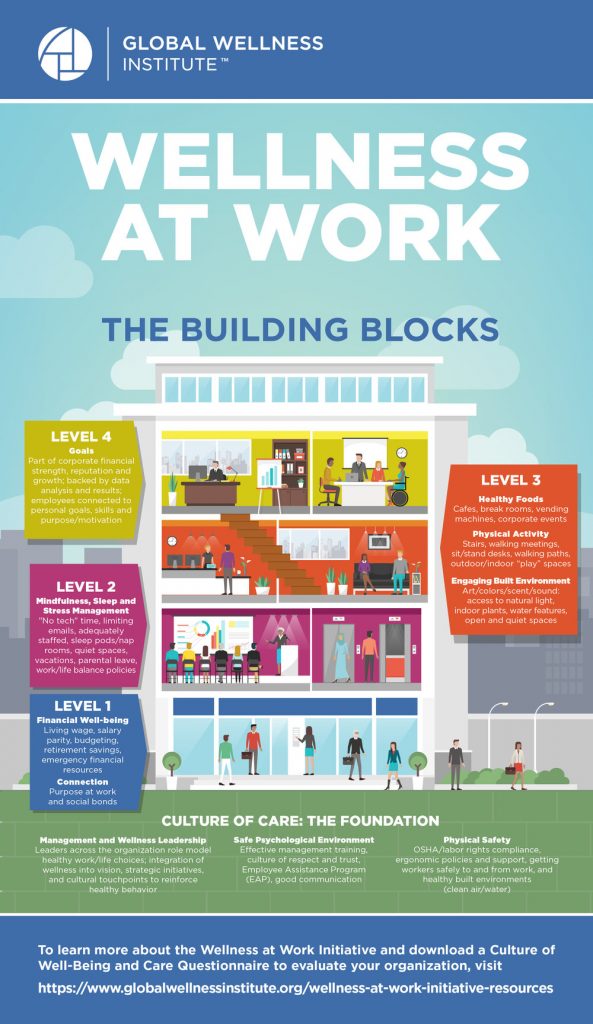There is a shift unfolding in the world of corporate wellness and culture. This shift has been a long time coming. Thanks to an overwhelming amount of data and research we have come to understand that the approach of working oneself to the bone and spending 10 hours at your desk is both counter-productive and ineffective. Studies have shown time and time again that those who are at the top of their field and consistently productive are those who prioritize their health and happiness. Nevertheless, initiating reform in wellness at work culture, operations, and delivery of health and wellness benefits can be an arduous task.
One of the questions I receive regularly as a Corporate Wellness Consultant is how to begin this process in organizations. Changing the culture and mindset of a community will take time and dedication. What I have found to be most effective is a strategic and incremental approach. Think about what unfolds with fitness and lifestyle in January every year. Resolutions are made, the gym is packed, and diets are started. More often than not by February most will have fallen off the wagon. As a wellness professional I have witnessed this unfold year after year. In my opinion the most effective way to launch a wellness program that will implement lasting change is to begin with small changes that over time will influence a shift in mindset and motivate teams and individuals to maintain a healthy and balanced lifestyle.
This article will detail a few of the strategic approaches I take when working with clients and organizations. Keep in mind that every situation is different, and your team may need to implement another plan. One of the most important parts of this process is to remain in conversation with the individuals and collective, be prepared to pivot if the plan is not providing the desired outcome.
- WHY
In the book “Start with Why” Simon Sinek tells us, “People don’t buy WHAT you do; they buy WHY you do it.” It is crucial that you know the why before you begin this process so that you may provide information when engaging in conversation with your peers and leaders. I am not referring to simply financial benefits, which can play a factor in the conversation, I am referring to the heart of wellness. Take time to ask questions and really listen to the answers and concerns. What do people find is their biggest obstacle in their personal health and wellness? What do they feel is the source of their stress? Are there ways in which they feel that they could benefit from further support? When you understand these needs, the answers will support you in the articulation of WHY.
2. RECRUIT THE LEADERSHIP
Perhaps you are part of the leadership, or perhaps you are working to influence the leadership to implement change. No matter what your position is if the leadership is not onboard and does not have the desire to support the team in new initiatives it will be hard to influence habits and change mindsets. We look to these people as our guides, our role models to show us the way. If they aren’t interested in taking part in the conversation and remaining engaged moving forward it will be hard for your initiatives to remain successful in the long run. Sharing solid facts and proven outcomes as well as the expected return on investment can support your conversation so be sure to do your research. For Example, The University of Michigan Research Center found that the ROI was $3 for every dollar spent on workplace wellness, and this proactive approach led to decreased turnover and increased productivity. Cultivating a positive environment emphasizing wellness will not only have lasting effects in the office, it will also improve overall quality of life for everyone engaging in the programming, management included.

3. PRACTICAL APPLICATION
One of the biggest concerns when companies begin a corporate wellness program, especially in the current economic climate is, “How much is this going to cost?”. Take a deep breath. It doesn’t need to be expensive. As I said at the beginning of the article, the best approach is to make gradual changes over time to initiate evolution in mindset and culture. It will not be effective or beneficial to drop a wellness bomb. Simple initiatives like breathing techniques for stress mitigation can be utilized in the moment and day to day. A great way to promote participation is to initiate stress prevention breaks throughout that day. Take 5 minutes to practice the breathing exercises twice a day company wide. This is only one very simple idea however the effects can be far reaching with consistency.
Taking these first steps is a great way to begin a conversation about health and wellness. One of the keys to success as you move forward is to remember there is no one size fits all approach. Be creative, listen, and remember WHY.
By Danielle Murray – Holos








